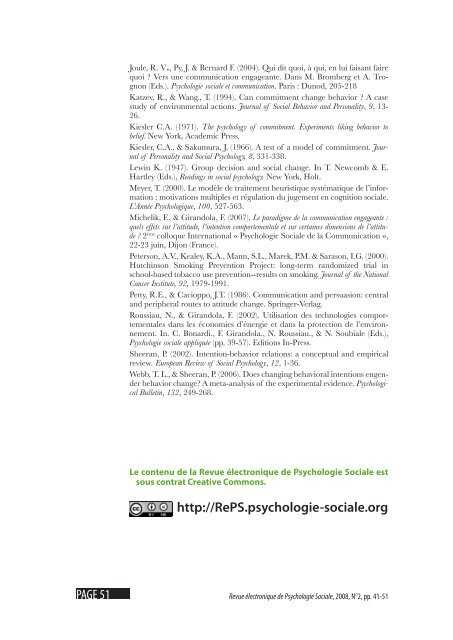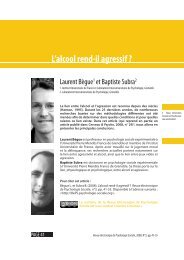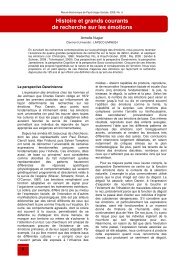Pourquoi les individus aident-ils moins autrui lorsqu'ils sont nombreux
Pourquoi les individus aident-ils moins autrui lorsqu'ils sont nombreux
Pourquoi les individus aident-ils moins autrui lorsqu'ils sont nombreux
You also want an ePaper? Increase the reach of your titles
YUMPU automatically turns print PDFs into web optimized ePapers that Google loves.
PAGE 51<br />
Joule, R. V., Py, J. & Bernard F. (2004). Qui dit quoi, à qui, en lui faisant faire<br />
quoi ? Vers une communication engageante. Dans M. Bromberg et A. Trognon<br />
(Eds.). Psychologie sociale et communication. Paris : Dunod, 205-218<br />
Katzev, R., & Wang., T. (1994). Can commitment change behavior ? A case<br />
study of environmental actions. Journal of Social Behavior and Personality, 9, 13-<br />
26.<br />
Kiesler C.A. (1971). The psychology of commitment. Experiments liking behavior to<br />
belief. New York, Academic Press.<br />
Kiesler, C.A., & Sakumura, J. (1966). A test of a model of commitment. Journal<br />
of Personality and Social Psychology, 8, 331-338.<br />
Lewin K. (1947). Group decision and social change. In T. Newcomb & E.<br />
Hartley (Eds.), Readings in social psychology. New York, Holt.<br />
Meyer, T. (2000). Le modèle de traitement heuristique systématique de l’information<br />
: motivations multip<strong>les</strong> et régulation du jugement en cognition sociale.<br />
L’Année Psychologique, 100, 527-563.<br />
Michelik, F., & Girandola, F. (2007). Le paradigme de la communication engageante :<br />
quels effets sur l’attitude, l’intention comportementale et sur certaines dimensions de l’attitude<br />
? 2 ème colloque International « Psychologie Sociale de la Communication »,<br />
22-23 juin, Dijon (France).<br />
Peterson, A.V., Kealey, K.A., Mann, S.L., Marek, P.M. & Sarason, I.G. (2000).<br />
Hutchinson Smoking Prevention Project: long-term randomized trial in<br />
school-based tobacco use prevention--results on smoking. Journal of the National<br />
Cancer Institute, 92, 1979-1991.<br />
Petty, R.E., & Cacioppo, J.T. (1986). Communication and persuasion: central<br />
and peripheral routes to attitude change. Springer-Verlag.<br />
Roussiau, N., & Girandola, F. (2002). Utilisation des technologies comportementa<strong>les</strong><br />
dans <strong>les</strong> économies d’énergie et dans la protection de l’environnement.<br />
In. C. Bonardi., F. Girandola., N. Roussiau., & N. Soubiale (Eds.),<br />
Psychologie sociale appliquée (pp. 39-57). Editions In-Press.<br />
Sheeran, P. (2002). Intention-behavior relations: a conceptual and empirical<br />
review. European Review of Social Psychology, 12, 1-36.<br />
Webb, T. L., & Sheeran, P. (2006). Does changing behavioral intentions engender<br />
behavior change? A meta-analysis of the experimental evidence. Psychological<br />
Bulletin, 132, 249-268.<br />
Le contenu de la Revue électronique de Psychologie Sociale est<br />
sous contrat Creative Commons.<br />
http://RePS.psychologie-sociale.org<br />
Revue électronique de Psychologie Sociale, 2008, N°2, pp. 41-51




